Managing International Business | Animal Cruelty As CSRs Issues
VerifiedAdded on 2022/08/17
|5
|1151
|17
AI Summary
Contribute Materials
Your contribution can guide someone’s learning journey. Share your
documents today.
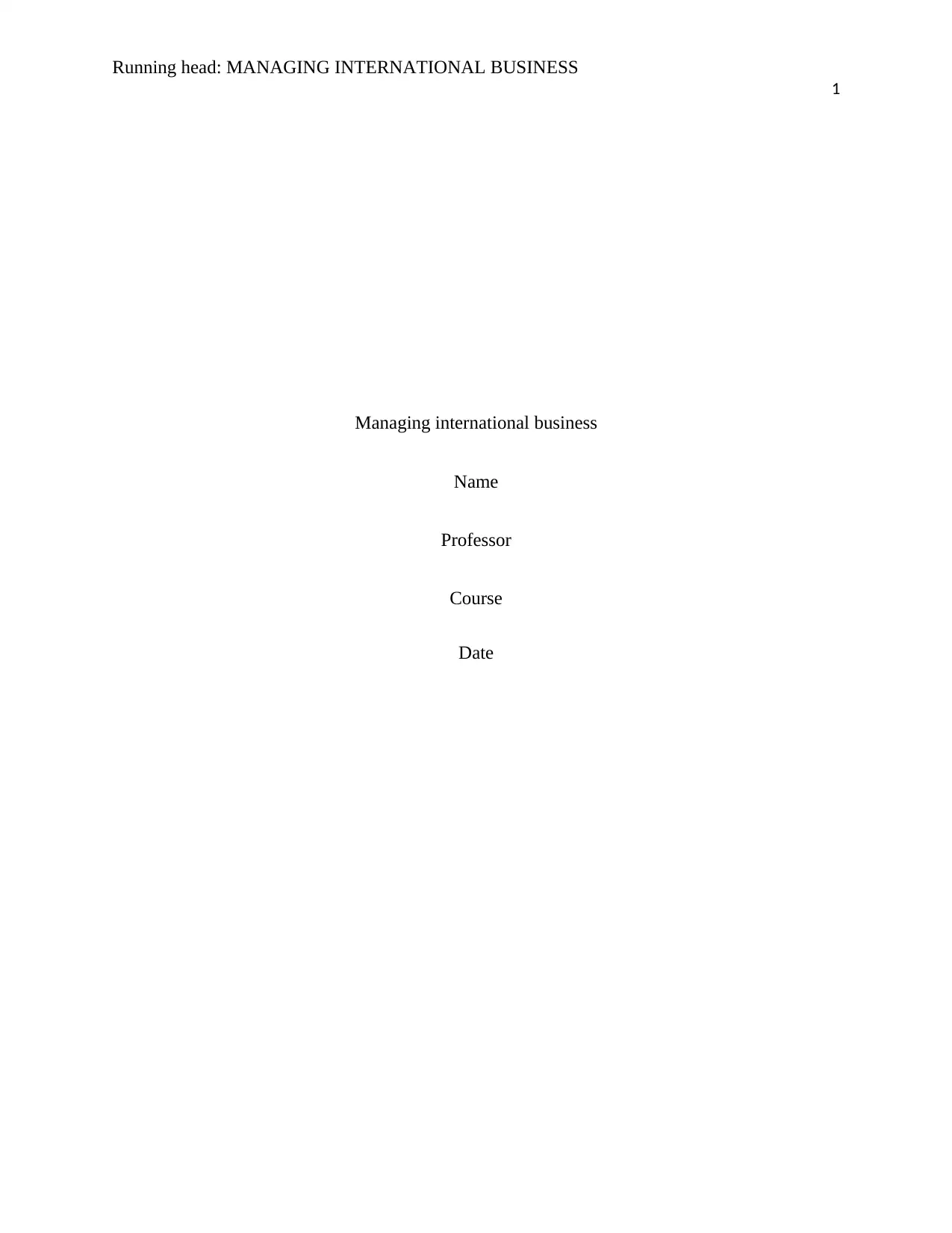
Running head: MANAGING INTERNATIONAL BUSINESS
1
Managing international business
Name
Professor
Course
Date
1
Managing international business
Name
Professor
Course
Date
Secure Best Marks with AI Grader
Need help grading? Try our AI Grader for instant feedback on your assignments.
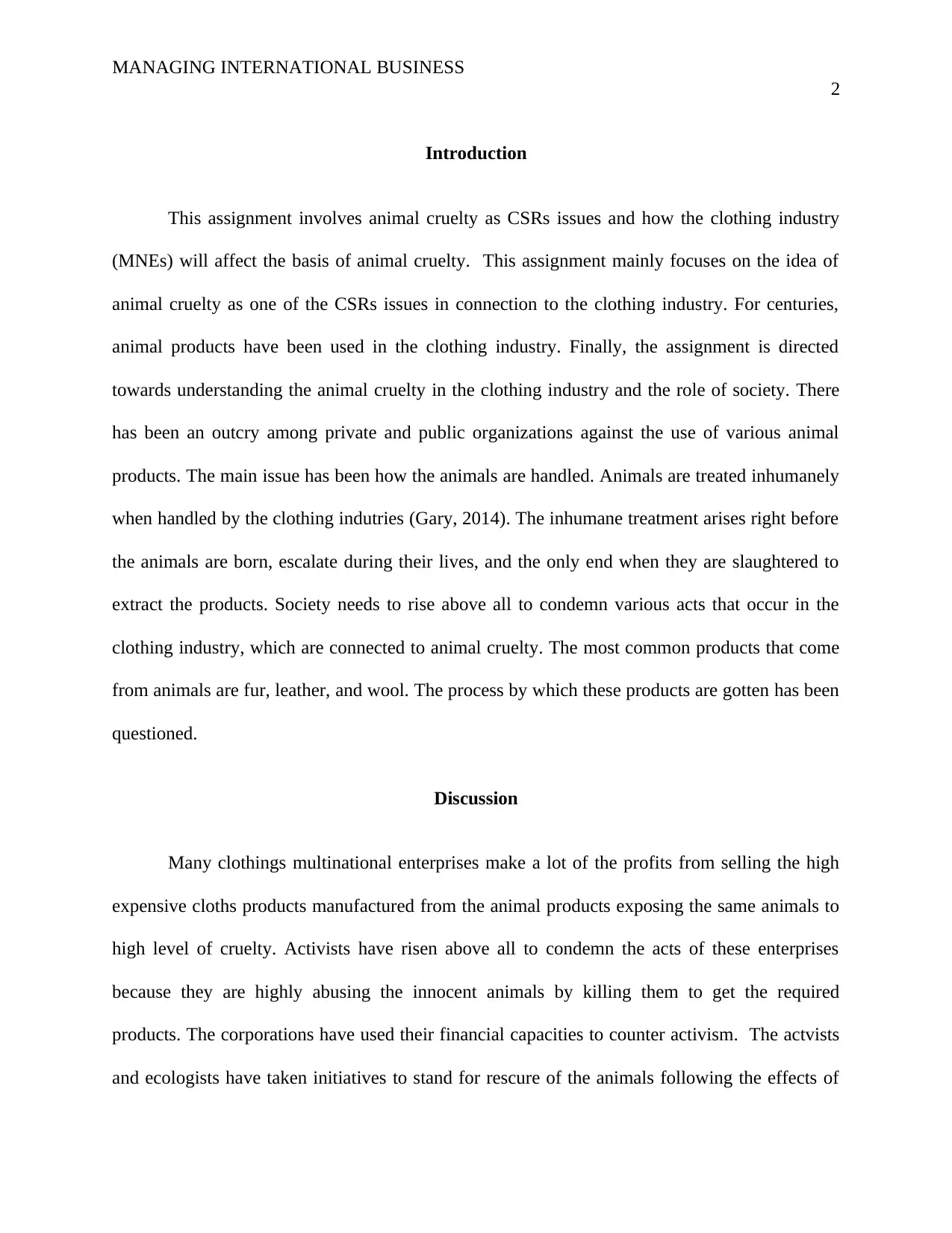
MANAGING INTERNATIONAL BUSINESS
2
Introduction
This assignment involves animal cruelty as CSRs issues and how the clothing industry
(MNEs) will affect the basis of animal cruelty. This assignment mainly focuses on the idea of
animal cruelty as one of the CSRs issues in connection to the clothing industry. For centuries,
animal products have been used in the clothing industry. Finally, the assignment is directed
towards understanding the animal cruelty in the clothing industry and the role of society. There
has been an outcry among private and public organizations against the use of various animal
products. The main issue has been how the animals are handled. Animals are treated inhumanely
when handled by the clothing indutries (Gary, 2014). The inhumane treatment arises right before
the animals are born, escalate during their lives, and the only end when they are slaughtered to
extract the products. Society needs to rise above all to condemn various acts that occur in the
clothing industry, which are connected to animal cruelty. The most common products that come
from animals are fur, leather, and wool. The process by which these products are gotten has been
questioned.
Discussion
Many clothings multinational enterprises make a lot of the profits from selling the high
expensive cloths products manufactured from the animal products exposing the same animals to
high level of cruelty. Activists have risen above all to condemn the acts of these enterprises
because they are highly abusing the innocent animals by killing them to get the required
products. The corporations have used their financial capacities to counter activism. The actvists
and ecologists have taken initiatives to stand for rescure of the animals following the effects of
2
Introduction
This assignment involves animal cruelty as CSRs issues and how the clothing industry
(MNEs) will affect the basis of animal cruelty. This assignment mainly focuses on the idea of
animal cruelty as one of the CSRs issues in connection to the clothing industry. For centuries,
animal products have been used in the clothing industry. Finally, the assignment is directed
towards understanding the animal cruelty in the clothing industry and the role of society. There
has been an outcry among private and public organizations against the use of various animal
products. The main issue has been how the animals are handled. Animals are treated inhumanely
when handled by the clothing indutries (Gary, 2014). The inhumane treatment arises right before
the animals are born, escalate during their lives, and the only end when they are slaughtered to
extract the products. Society needs to rise above all to condemn various acts that occur in the
clothing industry, which are connected to animal cruelty. The most common products that come
from animals are fur, leather, and wool. The process by which these products are gotten has been
questioned.
Discussion
Many clothings multinational enterprises make a lot of the profits from selling the high
expensive cloths products manufactured from the animal products exposing the same animals to
high level of cruelty. Activists have risen above all to condemn the acts of these enterprises
because they are highly abusing the innocent animals by killing them to get the required
products. The corporations have used their financial capacities to counter activism. The actvists
and ecologists have taken initiatives to stand for rescure of the animals following the effects of
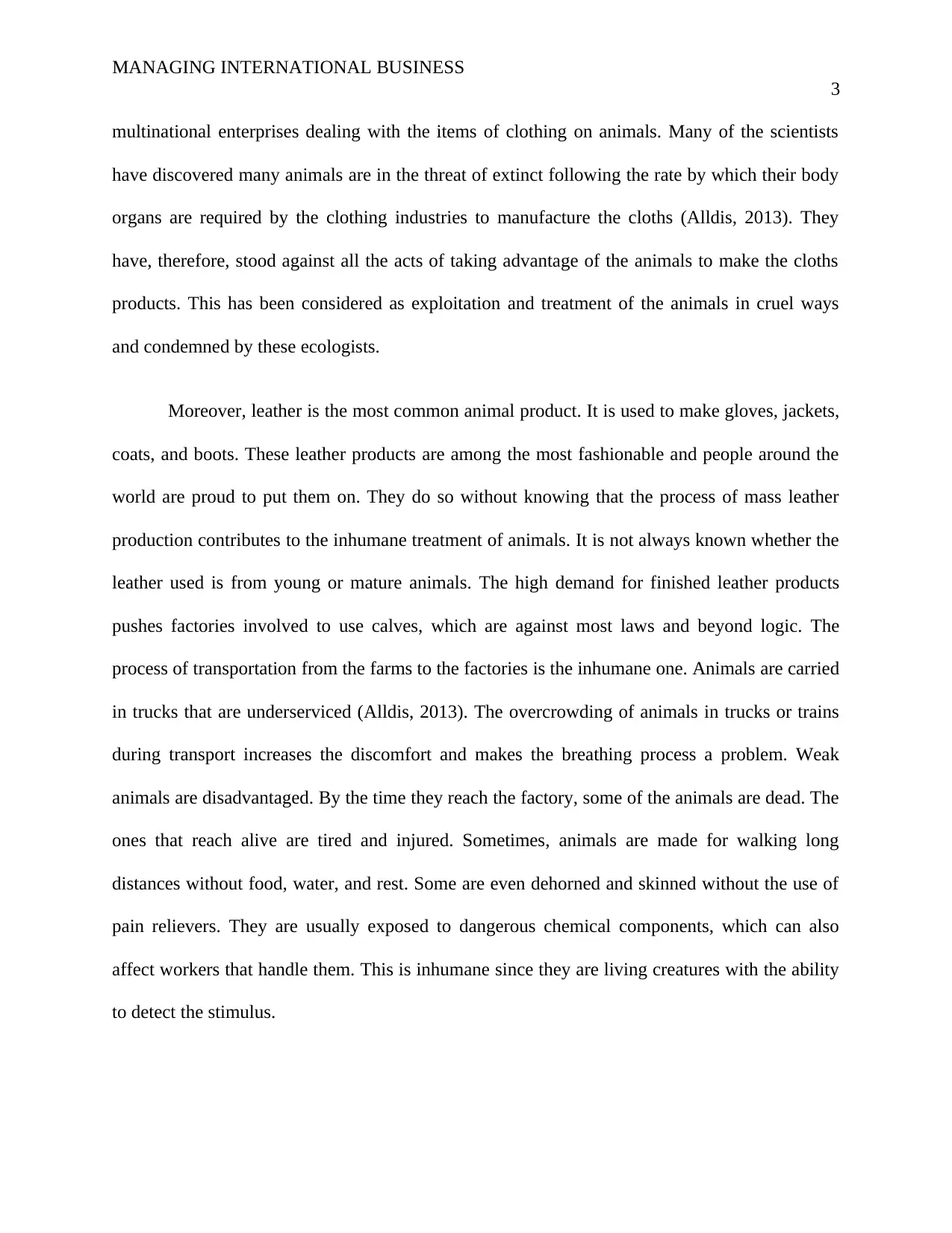
MANAGING INTERNATIONAL BUSINESS
3
multinational enterprises dealing with the items of clothing on animals. Many of the scientists
have discovered many animals are in the threat of extinct following the rate by which their body
organs are required by the clothing industries to manufacture the cloths (Alldis, 2013). They
have, therefore, stood against all the acts of taking advantage of the animals to make the cloths
products. This has been considered as exploitation and treatment of the animals in cruel ways
and condemned by these ecologists.
Moreover, leather is the most common animal product. It is used to make gloves, jackets,
coats, and boots. These leather products are among the most fashionable and people around the
world are proud to put them on. They do so without knowing that the process of mass leather
production contributes to the inhumane treatment of animals. It is not always known whether the
leather used is from young or mature animals. The high demand for finished leather products
pushes factories involved to use calves, which are against most laws and beyond logic. The
process of transportation from the farms to the factories is the inhumane one. Animals are carried
in trucks that are underserviced (Alldis, 2013). The overcrowding of animals in trucks or trains
during transport increases the discomfort and makes the breathing process a problem. Weak
animals are disadvantaged. By the time they reach the factory, some of the animals are dead. The
ones that reach alive are tired and injured. Sometimes, animals are made for walking long
distances without food, water, and rest. Some are even dehorned and skinned without the use of
pain relievers. They are usually exposed to dangerous chemical components, which can also
affect workers that handle them. This is inhumane since they are living creatures with the ability
to detect the stimulus.
3
multinational enterprises dealing with the items of clothing on animals. Many of the scientists
have discovered many animals are in the threat of extinct following the rate by which their body
organs are required by the clothing industries to manufacture the cloths (Alldis, 2013). They
have, therefore, stood against all the acts of taking advantage of the animals to make the cloths
products. This has been considered as exploitation and treatment of the animals in cruel ways
and condemned by these ecologists.
Moreover, leather is the most common animal product. It is used to make gloves, jackets,
coats, and boots. These leather products are among the most fashionable and people around the
world are proud to put them on. They do so without knowing that the process of mass leather
production contributes to the inhumane treatment of animals. It is not always known whether the
leather used is from young or mature animals. The high demand for finished leather products
pushes factories involved to use calves, which are against most laws and beyond logic. The
process of transportation from the farms to the factories is the inhumane one. Animals are carried
in trucks that are underserviced (Alldis, 2013). The overcrowding of animals in trucks or trains
during transport increases the discomfort and makes the breathing process a problem. Weak
animals are disadvantaged. By the time they reach the factory, some of the animals are dead. The
ones that reach alive are tired and injured. Sometimes, animals are made for walking long
distances without food, water, and rest. Some are even dehorned and skinned without the use of
pain relievers. They are usually exposed to dangerous chemical components, which can also
affect workers that handle them. This is inhumane since they are living creatures with the ability
to detect the stimulus.
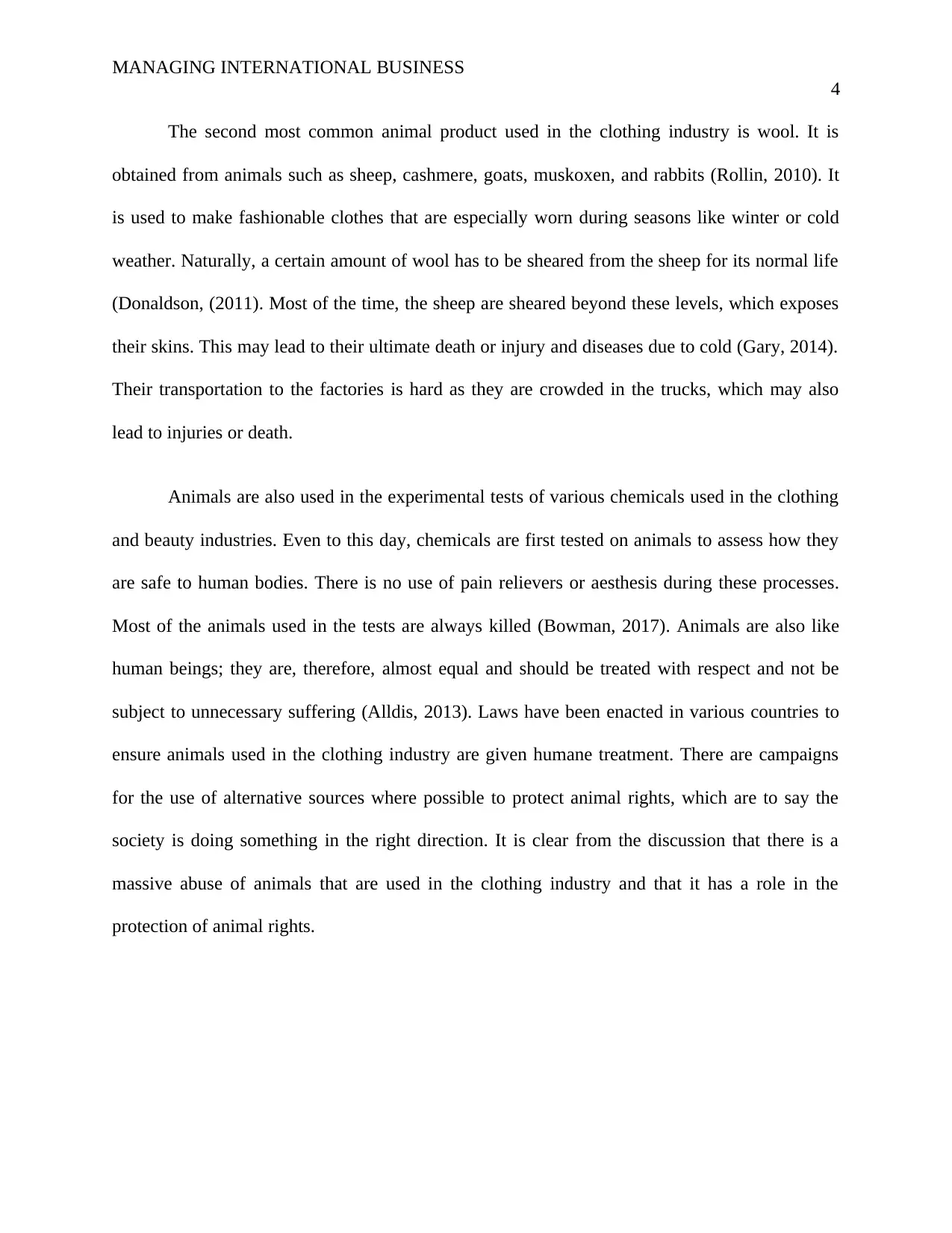
MANAGING INTERNATIONAL BUSINESS
4
The second most common animal product used in the clothing industry is wool. It is
obtained from animals such as sheep, cashmere, goats, muskoxen, and rabbits (Rollin, 2010). It
is used to make fashionable clothes that are especially worn during seasons like winter or cold
weather. Naturally, a certain amount of wool has to be sheared from the sheep for its normal life
(Donaldson, (2011). Most of the time, the sheep are sheared beyond these levels, which exposes
their skins. This may lead to their ultimate death or injury and diseases due to cold (Gary, 2014).
Their transportation to the factories is hard as they are crowded in the trucks, which may also
lead to injuries or death.
Animals are also used in the experimental tests of various chemicals used in the clothing
and beauty industries. Even to this day, chemicals are first tested on animals to assess how they
are safe to human bodies. There is no use of pain relievers or aesthesis during these processes.
Most of the animals used in the tests are always killed (Bowman, 2017). Animals are also like
human beings; they are, therefore, almost equal and should be treated with respect and not be
subject to unnecessary suffering (Alldis, 2013). Laws have been enacted in various countries to
ensure animals used in the clothing industry are given humane treatment. There are campaigns
for the use of alternative sources where possible to protect animal rights, which are to say the
society is doing something in the right direction. It is clear from the discussion that there is a
massive abuse of animals that are used in the clothing industry and that it has a role in the
protection of animal rights.
4
The second most common animal product used in the clothing industry is wool. It is
obtained from animals such as sheep, cashmere, goats, muskoxen, and rabbits (Rollin, 2010). It
is used to make fashionable clothes that are especially worn during seasons like winter or cold
weather. Naturally, a certain amount of wool has to be sheared from the sheep for its normal life
(Donaldson, (2011). Most of the time, the sheep are sheared beyond these levels, which exposes
their skins. This may lead to their ultimate death or injury and diseases due to cold (Gary, 2014).
Their transportation to the factories is hard as they are crowded in the trucks, which may also
lead to injuries or death.
Animals are also used in the experimental tests of various chemicals used in the clothing
and beauty industries. Even to this day, chemicals are first tested on animals to assess how they
are safe to human bodies. There is no use of pain relievers or aesthesis during these processes.
Most of the animals used in the tests are always killed (Bowman, 2017). Animals are also like
human beings; they are, therefore, almost equal and should be treated with respect and not be
subject to unnecessary suffering (Alldis, 2013). Laws have been enacted in various countries to
ensure animals used in the clothing industry are given humane treatment. There are campaigns
for the use of alternative sources where possible to protect animal rights, which are to say the
society is doing something in the right direction. It is clear from the discussion that there is a
massive abuse of animals that are used in the clothing industry and that it has a role in the
protection of animal rights.
Secure Best Marks with AI Grader
Need help grading? Try our AI Grader for instant feedback on your assignments.
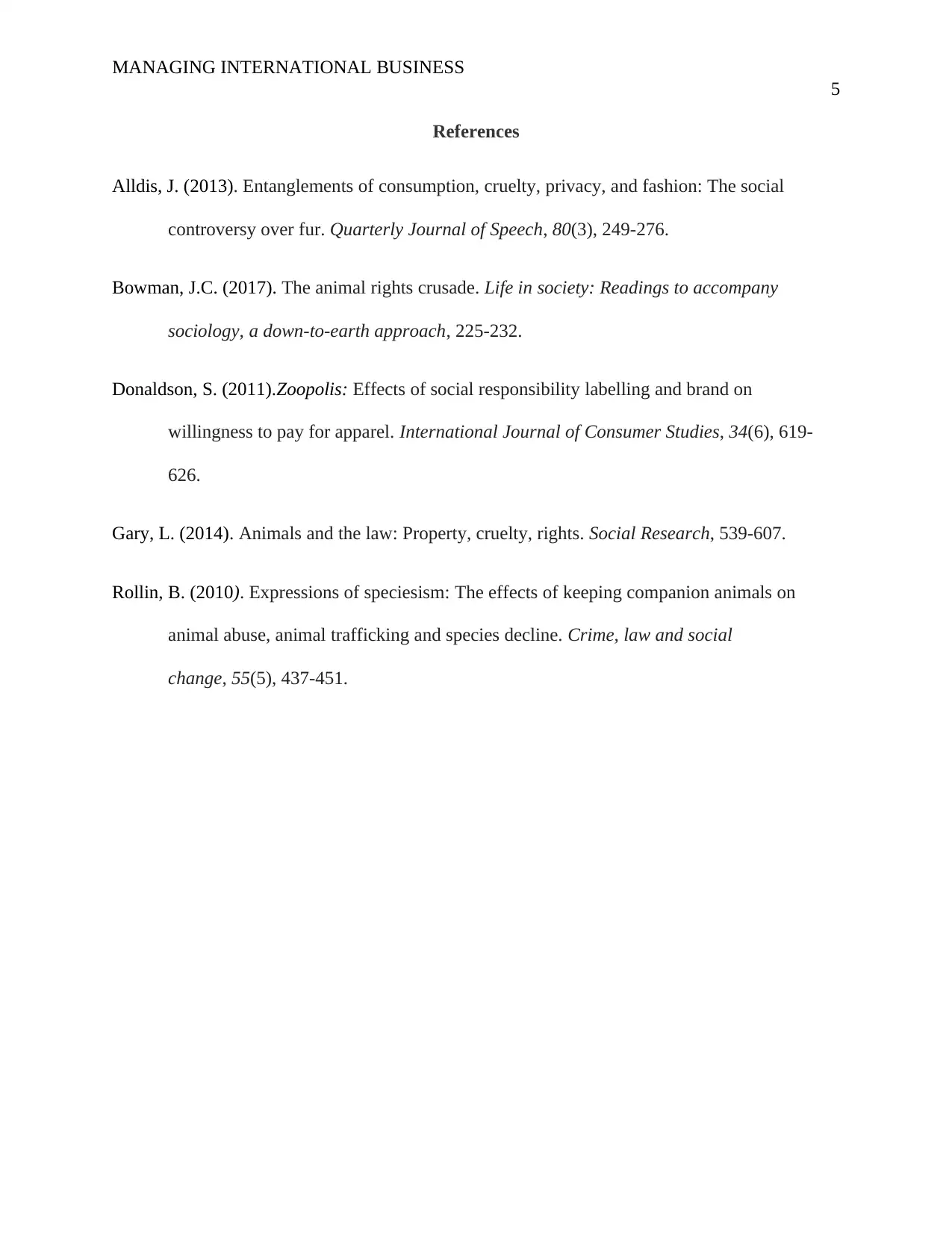
MANAGING INTERNATIONAL BUSINESS
5
References
Alldis, J. (2013). Entanglements of consumption, cruelty, privacy, and fashion: The social
controversy over fur. Quarterly Journal of Speech, 80(3), 249-276.
Bowman, J.C. (2017). The animal rights crusade. Life in society: Readings to accompany
sociology, a down-to-earth approach, 225-232.
Donaldson, S. (2011).Zoopolis: Effects of social responsibility labelling and brand on
willingness to pay for apparel. International Journal of Consumer Studies, 34(6), 619-
626.
Gary, L. (2014). Animals and the law: Property, cruelty, rights. Social Research, 539-607.
Rollin, B. (2010). Expressions of speciesism: The effects of keeping companion animals on
animal abuse, animal trafficking and species decline. Crime, law and social
change, 55(5), 437-451.
5
References
Alldis, J. (2013). Entanglements of consumption, cruelty, privacy, and fashion: The social
controversy over fur. Quarterly Journal of Speech, 80(3), 249-276.
Bowman, J.C. (2017). The animal rights crusade. Life in society: Readings to accompany
sociology, a down-to-earth approach, 225-232.
Donaldson, S. (2011).Zoopolis: Effects of social responsibility labelling and brand on
willingness to pay for apparel. International Journal of Consumer Studies, 34(6), 619-
626.
Gary, L. (2014). Animals and the law: Property, cruelty, rights. Social Research, 539-607.
Rollin, B. (2010). Expressions of speciesism: The effects of keeping companion animals on
animal abuse, animal trafficking and species decline. Crime, law and social
change, 55(5), 437-451.
1 out of 5
Your All-in-One AI-Powered Toolkit for Academic Success.
+13062052269
info@desklib.com
Available 24*7 on WhatsApp / Email
![[object Object]](/_next/static/media/star-bottom.7253800d.svg)
Unlock your academic potential
© 2024 | Zucol Services PVT LTD | All rights reserved.

